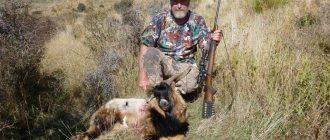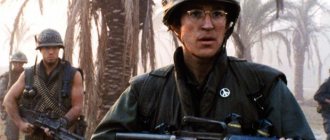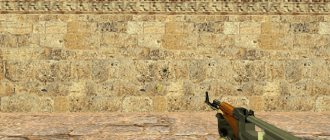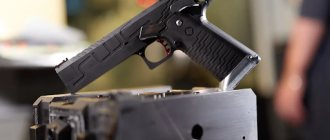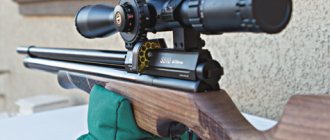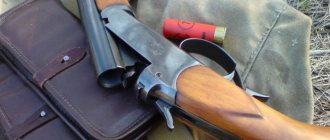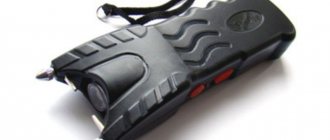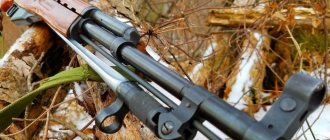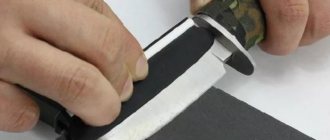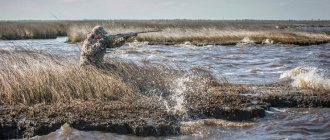- October 23, 2018
- Weapons and ammunition
- Human
Even the best guns and cartridges will not help protect yourself or catch game if a person does not know how to shoot a gun correctly. Of course, you can’t do this without practice. But for it to be successful and effective, a high-quality theoretical basis is necessary. An alternative is to use trial and error. But it is characterized by an increased amount of spending money and time.
Introductory information
In order to learn to shoot well, one uses either an experienced way or special training. But in the first case, you can devote your entire life to learning, but still not understand the many elementary subtleties of proper firing. Therefore, in order not to waste time and money on understanding how to shoot a gun correctly, you need to prepare. In practice (for example, when hunting) you have to fire at fixed/moving targets. For example, if a hazel grouse is frozen on a branch ten meters away, then intuitively it is not difficult to hit it. It is enough to throw the gun to your shoulder, bring the upper cut of the front sight to the point and smoothly, without jerking, pull the trigger. Although not everything is as easy as it might seem at first glance.
Firearms
This is one of the most dangerous types of weapons. It is necessary to destroy a target at a short distance. Firearms are very dangerous. Shooting from it is almost impossible without preparation. The device has strong recoil. This point must be taken into account in order to hit the final goal. If a person shoots without training, who does not know the principles of operation of this weapon, then he will not succeed. Moreover, he may harm himself. Therefore, firearms must be treated with the utmost seriousness and caution. Otherwise, this may lead to various negative consequences. It should be noted that firearms, in turn, are also divided into categories, each of which will be discussed below.
Specifics of shooting
Speaking about how to properly aim with a shotgun, it is necessary to note the fact that it is necessary to use both eyes in an open state. This is necessary in order to more accurately determine the distance to the target. This is very useful when it moves additionally and has a small affected area. For example, a duck that swims on a lake. In this case, it is advisable to aim for the neck. And you should not hesitate - after all, even if the target does not move quickly, it can leave the affected area. Many people spread rumors that it is necessary to keep the bar closed or open in specific cases. This is all fiction - everyone decides for themselves what is convenient for them. Also, do not forget about anticipation. Experienced hunters can take the correct distance without hesitation. Also, in cases where the game is still showing signs of life, it must be finished off immediately (but not with the butt of a gun, as it may break). After all, wounded animals often hide from hunters. In addition, it is necessary to accurately remember the places where game falls and try to quickly get it. It is also unacceptable to shoot at birds during migration when they fly over impassable thickets. After all, even if the game is killed on the spot, it will be difficult to find. And finding a wounded animal is a significant success. Therefore, it is always necessary to ensure that the game falls in a clean place.
Common mistakes when hunting with shotguns
Even dedicated hunters make common mistakes. Therefore, it is better to familiarize yourself with them in advance and control these points during training.
- Aiming at a moving target without anticipation. Depending on the distance, a bullet from a smoothbore gun flies to the target in 0.01 to 0.2 seconds. This is quite short, but for fast-moving game this moment is enough to avoid defeat. Therefore, when hunting game on the move, it is important to take into account the speed of the target’s movement and take aim while taking a lead. Beginner hunters, especially those who have not been trained, often do not know about this rule and point the fly directly at the object of the hunt.
- A sharp pull on the trigger. Shooting is a rather sharp and noisy phenomenon. But this does not mean that it should be done quickly and impulsively. The secret of a successful defeat lies in the calmness of the shooter and the balance of his decisions. Calm down, hold your breath and pull the trigger smoothly. Neither before nor in the first moments after the shot should the weapon be moved or jerked - this will throw off the aim.
- Long preparation. Long preparation for the moment of shooting is what distinguishes shooters with little experience. When hunting, reaction speed and automaticity of movement are important. Most often, a hunter has only a couple of seconds to raise his gun, take aim and fire a shot. Delay threatens that the game will escape. For hunters with extensive experience, aiming and shooting have become automatic. But beginners have to hone such skills for a long time.
- Changing the angular velocity of the barrel. While leashing the barrel of a weapon behind game, you cannot change the speed of its movement. Beginner shooters have the sin of trying to stabilize the barrel before pressing the trigger and unknowingly slowing down their movements. To avoid a miss, there is no need to slow down the leash before the shot and for some time after, so as not to disrupt the trajectory of the bullet.
- Leash by hand only. The leash should be carried out by turning the body. This way the shooter’s position remains more stable and the stock is held more stable. Until this skill is mastered, novice shooters unconsciously try to perform this action with only their hands. Experienced hunters leash with their body in a kneeling or lying position.
- Unaimed volleys. If game comes into view suddenly, it is better to let it go. You should not take a shot at random without precise aiming and preparation.
- Hunting for the pack. If a whole flock of birds flies in front of the hunter, it is not advisable to shoot at random, even if the density is quite high. Be sure to mark only one and hit, targeting the base of the neck. The bird that flies first is often chosen. Then there is a high probability that the middle point of impact will be on other individuals of the flock.
To learn how to accurately hit prey, you should spend a lot of time training. The main condition - do not forget about the rules of shooting from smooth-bore weapons, the safe use of weapons and obtaining a permit for the extraction of hunting resources.
Shooting at a moving target
It can be performed using various techniques - offhand or with a leash. In such cases, it is necessary to have a lightning-fast reaction and a spreading weapon. Every hunter needs to be able to accurately determine the distance to a target within a range of up to seventy meters. This is if a smoothbore gun is used. A rifled weapon requires correct determination of the distance at least within 300 meters. In addition, it is necessary to shoot, as experienced hunters say, always in moderation. And it is advisable to use smaller ammunition if this is reasonably possible. Thus, a duck will be more reliably hit by five small pellets than by one large one. Although you shouldn't tempt fate. For example, take shot No. 12 for bear hunting.
How to improve performance?
Beginners are advised to go hunting with experienced people. They will tell you how to properly hold a gun when shooting, aim, and shoot. If something was misunderstood, they will correct it. It is advisable to start with simpler guns that do not provide ample opportunity to fire large quantities of ammunition. For example, single- and double-barreled guns have a disciplinary effect, forcing you to approach hunting more carefully. After all, if there is only one cartridge, then if you miss, then there will be no more opportunity to get game. And if it is also dangerous (a bear or a wild boar), then the hunter himself may suffer - even death. Therefore, it is recommended to choose double-barreled shotguns. They give you another chance to improve the situation. Whereas if semi-automatic weapons are used, then when the hunter gets excited, he can release all the ammunition with little effect. But how much do they cost!
Choosing the right weapon
Often the design of the weapon itself interferes with accurate shooting. Experienced hunters know that sometimes there are guns that are designed so poorly that it is impossible to pick them up correctly at all.
It happens that the weapon was altered independently and was done incorrectly. Therefore, if, even if you follow all the rules of grip, it seems to you that the weapon in your hands is not obedient enough, then you should contact a professional gunsmith. Only a well-fitted gun in the hands of a good shooter will bring pleasure from shooting and produce results during the hunt.
About Study Tips
First of all, you need to figure out how to properly aim a gun. It is advisable that it have a rear sight and a front sight. And then comes the turn of the stationary target. You can send it to a shooting range or to a wasteland for human settlements. Initially, it is necessary to teach how to hold the weapon so that the rear sight and front sight coincide. In this case, you need to stand in a stance, resting the gun on your shoulder. When the weapon is already confidently held in your hands, you can start shooting at a stationary target. But it’s worth aiming at the moving one for now. No need to worry. You should shoot calmly. The main goal is to learn how to fire well. Since almost everyone has shot an air rifle at some point, there shouldn't be any problems with this exercise. But at the same time it is always necessary to press the gun tightly to your shoulder. This simple tip allows you to reduce recoil and not throw the barrels away from the aiming point. This is very important for subsequent shots. It is necessary to strive to ensure that there is no gap between the cheek and the butt, that is, they must be pressed tightly against each other.
Hunting rifle shooting basics
Sighting a shotgun and its technique
Sighting a shotgun is carried out to determine the quality of the shotgun and to select cartridges that meet the purposes of hunting. The firing of a shotgun is characterized by accuracy, consistency, sharpness, accuracy and uniformity of the shot shell. These qualities are determined when shooting from the hand while standing with careful aiming (preferably from a rest). Shotgun zeroing can be carried out at shooting stands, in shooting ranges or in specially adapted places with natural fencing (ravines, ditches, hills, etc.) that ensure safety for humans and domestic animals.
To zero a gun, 6 cartridges with identical charges of gunpowder and shot shells are loaded for each barrel. The gun is zeroed on large (at least 1 m2) sheets of paper with an aiming point marked on them or on special targets, 100- or 16-length. Prepared 6 sheets of paper (targets) are alternately attached to a shield of boards. The results of the battle are determined by 5 targets, since one of them with the most dramatic, usually random deviations is not taken into account. The accuracy of the battle is judged by the degree to which the center of the shot pattern coincides with the aiming point. This allows you to determine how accurately the gun barrels direct the projectile to the aiming point. The center of the scree is determined by placing a wire circle with a diameter of 75 cm or drawing a circle with a radius of 37.5 cm on the target using thread, a needle and a pencil. The center of the circle is taken as the center of the scree.
Having determined the scree centers on all targets, measure the distance of each scree center from the aiming point and calculate the average deviation for a series of shots. For a good gun, the deviation should not exceed 75 mm, and for individual shots in a series - 150 mm. In the same way, the average deviation of the center of impact of the right and left barrels is determined, which should not be more than 100 mm. If the deviation of the centers of the beads is large, this means that the gun fires incorrectly; it must be taken to a workshop for inspection and correction.
The consistency of the battle is characterized by stable accuracy and uniformity of scree. The determination of the constancy of the gun's engagement is made using those targets for which the accuracy of the engagement was determined, and then it is clarified during further zeroing. Combat consistency is considered satisfactory if the difference between the accuracy of the best and worst shots does not exceed 25-30% of the average accuracy.
The sharpness of the combat, which depends on the initial speed of the shot as it leaves the barrel, refers to the penetration ability, i.e., the force of impact of the shot on the target. The sharpness of the shot is determined by measuring the depth of penetration of the shot into a dry pine board. The sharpness of the battle can be considered satisfactory if, when firing with shot No. 7 at a distance of 35 m, another shot can enter the hole.
The sharpness of the battle depends on the increase in the gunpowder charge, but in this case the accuracy decreases, which is measured by the number of pellets per unit area of the target. With a good fight, the accuracy of the scree should ensure that 4-5 pellets hit the game. The degree of accuracy depends on the nature of the hunt. Greater accuracy of scree is needed when shooting at game over long distances (for example, when shooting at birds on migration), but it can be harmful when shooting from under a dog, especially in the forest, and can cause misses or damage to the game.
Determination of the accuracy of the battle is carried out by counting the pellets that fall into a circle with a diameter of 75 cm when shooting at a distance of 35 m with shot No. 7, and is expressed either by the number of pellets or as a percentage. To express accuracy as a percentage, you need to know the number of pellets in the projectile. It is known that 1 g of shot No. 7 contains 10-11 pellets; therefore, a projectile weighing 30 g contains 315 pellets, i.e. 10.5X30. If 237 pellets hit the circle, then the percentage accuracy can be determined as follows: - 100 = 75%. Since the accuracy of the shot depends on the drilling of the barrel, it is necessary to keep in mind that the normal accuracy of barrels of various drillings is expressed as average percentages when shooting with shot No. 7: cylinder - 35, cylinder with pressure - 40, pay - 55, average choke - 65 and strong choke - 75 to 90 (Fig. 82).
The uniformity of the scree serves as an indicator of the distribution of the shot shell on the target. The shot must be distributed so that game cannot get between the shot and remain unhit. If the shot falls thickly, but in some places it is not there, then the scree is abnormal. Determination of the uniformity of the scree is carried out by counting hits in various zones of the target circle and the number of unaffected lobes.
Rice. 1. Scree when fired: a - scree when fired from the barrel of a cylindrical drill (improved cylinder) - uniform distribution of pellets over the entire target area without condensation towards the center; b - scree when fired from a barrel with a light check drill - greater accuracy compared to the cylinder with condensation towards the center;
Determining the most advantageous weight of powder charge and shot shell
The more favorable weight of the powder charge and the shot shell is determined when the gun is zeroed at 100-length targets at a distance of 35 m with shot No. 7.
To zero a gun, 4-6 series of 3, 5, 10 rounds each with powder charges of different weights or shot shells are loaded. Shooting is done standing from hand. Sighting should be carried out on the same day with short breaks to ensure the same shooting conditions. Targets are prepared according to the number of expected shots. On each target there is information about the weight of the gunpowder charge and the weight of the shot shell of the cartridge that will be fired at this target. To simultaneously determine the sharpness of the battle, it is recommended to attach targets to panels made of dry boards. The series of cartridges are loaded so that one half of the series has cartridges with the same powder charges, but different shot shells, the other - cartridges with the same shot shells, but different gunpowder charges. For example, for a 16-gauge shotgun, zeroed with Sokol gunpowder, the following four series of cartridges can be equipped (weight of gunpowder and shot, g):
The more series and cartridges in each of them, the greater the number of possible combinations and, therefore, the more accurate the weight of the charges and projectiles tested. After shooting, they begin to determine the results. The most advantageous cartridges for hunting have satisfactory sharpness, provide normal accuracy and better uniformity of scree. Based on the results of the battle, the best charges of gunpowder and shot shells are determined, which must be strictly adhered to when loading cartridges for hunting.
It should be borne in mind that changes in the quality of the fire largely depend on the air temperature and on changes in the brand of gunpowder used.
The gun can also be zeroed on a 16-lobe sighting target (diameter 75 cm), which is simpler and more convenient than a 10-lobe sighting target.
The areas of all 16 lobes (4 located in the inner circle with a diameter of 37.5 cm and 12 in the outer ring) are equal to each other. Each target field corresponds approximately to the size of a black grouse carcass, and two adjacent ones correspond to the slaughter area of a running hare. The uniformity of the shot fall is determined from the ratio of the number of affected lobes to the total number of pellets hitting the target. Scree is considered satisfactory if there are 12 holes of 2.5 mm shot in one field or 5 holes of 3.5 mm in two adjacent fields. The rating is made based on the average of five or more shots.
Shooting position and its types during hunting
Depending on the nature of the hunting grounds and the type of hunting, you have to shoot from different positions: standing, kneeling, sitting and lying down. There are no rules defining one or another shooting position. The most convenient and most often used during hunting is the standing position. In order to better use the fighting qualities of a gun, including its grip, the hunter must learn the correct stance and position of the gun when firing.
When shooting while standing, the hunter faces in the direction of the most likely appearance of game, puts his right leg to the right and back approximately shoulder-width apart, distributes the weight of the body evenly on both legs; The gun is held at waist height, the left hand supports the barrels under the fore-end with the elbow slightly bent and lowered, the right hand covers the neck of the stock and holds the butt against the right side. The middle finger, holding the gun by the neck, should not touch the trigger guard, and the index finger is placed in the guard and rests with the first phalanx on the trigger. Before firing, the hunter raises the gun, placing the butt plate tightly into the notch of the shoulder; in this case, you need to raise the elbow of your right hand up to shoulder level to better open the shoulder notch. For correct aiming, it is necessary to lightly press your cheek against the ridge of the butt so that the eye, the slot of the aiming bar, the front sight and the target are in the same line. You need to aim at the game (if the target is motionless).
The accuracy of the hit depends on careful aiming and, to a large extent, on the correct release of the trigger. The trigger must be pulled smoothly. When you pull the trigger, the projectile will land below the target. When hunting, you have to shoot at a stationary and moving (flying or running) target. The main condition for successful shooting while hunting is the ability to quickly determine where to point the shot shell in order to ensure an accurate hit to the target. Also important are the firing range, the correct choice of shot number, cartridge equipment, the adaptability of the gun and the training of the hunter-shooter.
Shooting distance and shot numbers acceptable for successfully hitting game
To hit a target, 4-5 pellets of the corresponding number must hit its most vulnerable places, and the flight speed of these pellets at the moment of meeting the target must be at least 190-200 m/sec. At lower speeds, the sharpness of the battle becomes insufficient. Modern gunpowder “Falcon”, “Pheasant” and others impart an initial velocity of approximately 375 m/sec to the shot. When shooting with shot (the most common numbers), the maximum range of actual rifle fire is 40 m, when shooting with smaller numbers of shot - even 30 m.
Accuracy of shot beyond 40 m does not ensure accurate hitting of the target. Having flown out of the barrel in a compact mass, the pellets quickly disperse and deviate from the axis of the shot. In addition, deformed and smaller pellets fly slower, the projectile stretches in length by 1.5-2.0 m. Beyond 40 m, hitting a target depends not on the skill of the shooter or on the combat of the gun, but on chance. At long distances, the accuracy and sharpness of the shot is so small that for every accidentally killed game there are many wounded wounded animals that are crippled and gone. The purpose of hunting is to obtain, not to mutilate, game. You should only shoot when the target is within reach.
The choice of shot number is of great importance for successful shooting. A shot smaller than that recommended for this type of hunting cannot cause sufficient damage to an animal or bird, and with a larger shot, the small number of pellets in the projectile does not provide the required accuracy.
Shooting at stationary targets
Shooting at a stationary target is simple. The hunter is required, in addition to knowing the combat of his gun, to correctly select the aiming point and smoothly release the trigger. With most modern guns, you need to aim at the game approximately at the line of contact of its carcass with the surface of the water, ground or twig.
When shooting at several birds sitting on the water or at a flock, you need to aim at a specific bird, and not shoot “in a bunch,” since in the latter case there are often wounded wounds and even misses.
Shooting while hunting at a moving target
Shooting at a moving target is complicated by the fact that the game is in the field of view for a limited time. Therefore, in order to hit the target, the hunter must send the charge not directly at it, but at the point of the expected intersection of the lines of movement of the target and the shot shell, i.e. take a lead.
Shooting at a moving target is done at the "heads up" position and with a "leash", or, as they say, "with a moving gun". When shooting at the "saddle" position, the shooter looks only at the target and at the point where he wants to send the projectile, pulls the trigger at the moment the butt of the gun touches the shoulder. The amount of lead with this method of shooting depends on the time it takes for the shot to reach the target. They shoot at a glance in cases where an instant shot is required, for example in reed thickets or in the forest. Shooting sideways requires great skill from the hunter.
When shooting with a “lead”, the shooter points the gun with the barrels at the target, moves it along the target’s line of movement for some time with the necessary lead, and then presses the trigger without stopping the movement of the gun at the moment of firing. The second type of shooting with a “leash” is that the hunter, having taken the target at gunpoint, leads the gun behind the target for some time and, at the moment of pressing the trigger, jerks the barrels forward in the direction of the target’s movement, to a distance that, in the shooter’s opinion, must be equal to the required lead; The gun must be in motion at the moment of firing.
Rice. 2. Options for shooting at a flying bird: a - at a high-speed bird, b - at a low-speed bird, c - at a high-speed bird, d - at a low-speed bird, e - at a bird going up, f - lateral lead
Rice. 5. Lead when shooting at a moving animal: a - at a stolen hare, b - at an oncoming hare, c - at a hare moving at an angle of 90°, d - lead when shooting at a fox, e - at a wolf
Rice. 6. Aiming point for a hare running past the shooter
Rice. 7. Aiming point for a bird flying past the shooter
If the lead when shooting with a smooth lead is 1.5 m, then when shooting with a “jerk” it will be half as much. A smooth leash is easier for novice hunters to master.
The concept of clay pigeon shooting and its purpose (shooting and hunting sports)
When hunting, you most often have to shoot at moving targets. This necessary and more difficult type of shooting can be learned on the bench.
A shooting range is a shooting range where special structures and equipment are located to ensure shooting at fast-moving targets (flying saucers). There are trench, round and complex stands. The trench stand facilitates the development of hijacking shots, the round one - shots at a fast-moving target to the right or left of the shooter, as well as at an oncoming target and hijacking.
At the stand, the novice hunter gets the opportunity to fire a large number of shots, carried out according to a specific system that meets the shooting requirements of hunting, and develops a fast rate of fire. In addition, the stand provides an opportunity to meet experienced hunters and acquire the necessary knowledge. In the system of hunting societies, hunting and shooting sports have become widespread. Many members of society engage in it. Some of them undergo initial shooting training, others are trained in advanced marksmanship courses, and others are improved under the Master of Sports program. From among the best shooters, training groups and national teams are created that take part in hunting and shooting competitions,
Rice. 8. Aiming point for a bird flying over the shooter's head
Rice. 9. Aiming point for a hijacking descending bird
Rice. 10. Aiming point for an oncoming descending bird
Rice. 11. Aiming point for an oncoming rising bird
Rice. 12. Aiming point for a hare running towards a hunter
Rice. 13. Aiming point for a stolen rising bird
More tips
Your feet should be shoulder-width apart. If a person is right-handed, then you should move your left hand forward. The body must be tilted forward. This dampens the recoil to a certain extent. Then you can point the front sight at the target and shoot. There is no need to listen to would-be theorists who recommend pulling the trigger slowly. This must be done smoothly but quickly. If you waste time aiming for a long time and pressing the shutter, you can shoot into an empty place. After all, game is not a target. She won't wait. It is necessary to release the trigger with the first phalanx of the index finger. But beware of making a dash. It is necessary to shoot until all motionless targets at 20, 35 and 50 meters are quickly and confidently hit.
How to position your hands
The hand that pulls the trigger should lie freely and should not be restrained by anything. Sometimes there are guns in which the butt is shaped in such a way that in order to properly grasp the gun you have to twist your wrist. This reduces the accuracy and efficiency of shooting. Professionals advise changing the shape of the front part of the butt comb or even completely replacing the rifle stock. This will give your hand more space. But it is not recommended to do this yourself. Such changes to the design should only be carried out by a master gunsmith.
The shooter usually places his second hand in the middle of the fore-end. In this case, it is especially important to control the grip force. Shooting masters teach that the forend should be held in the palm of your hand as if it were a handful of eggs. You may not get this grip right the first time, but you still have to master it.
Hunting big game allows you to use a little more force when holding the weapon. But the grip force on the fore-end should be kept to a minimum. Of course, it should be enough for confident and precise shooting control.
It is important to position your index finger correctly. Instructors advise placing it so that it is aimed at the target. At first, this hand position will not seem very comfortable, but over time the skill will take hold and become a habit. When the index finger is positioned in such a way that it seems to be pointing at the target, this helps the shooting accuracy at the level of instinct. Typically, the instructor will ask the novice shooter to raise his left hand with his index finger extended forward and mark his target. The brush should be held relaxed, without tension. Then the student is asked to turn his half-open palm upward. This will be the optimal position of the front hand when shooting.
Hitting a moving target
Here it is important not to forget about the skills that were acquired in the previous stages. Shooting from a gun should be done frequently - preferably every other day or two. It is necessary to achieve a situation so that after raising the weapon, its butt is pressed tightly against the shoulder and cheek, and the bar is not visible. When trying to hit a moving target, you must move your body, not your arms. They are needed solely to move vertically. Many people, when turning to the right, often involuntarily help themselves with their hands. To avoid this error, it is necessary to move so that the body is initially slightly offset relative to the aiming point. This is the only way to learn how to properly shoot a gun at a moving target.
About anticipation
It is simply impossible to avoid this topic by talking about how to properly shoot ducks and other small game with a gun, which at the same time moves very quickly. You can take the bureaucratic route and learn the lead sizes that are taken when hunting from different angles and at different distances. Or you can use other approaches. For example - calculations in buildings. Or use the barrel of a gun to calculate the required lead. The last option is also very easy. You also need to be prepared to lead the game if it notices danger and decides to change its trajectory. Or he will simply decide to go somewhere else.
Correct Practice
When questions about how to properly shoot a hunting rifle are raised, elementary rules of behavior cause a lot of misunderstanding. For example, after the first shot, when the target is not hit, many people rush and shoot in the same direction a second time. This very often turns into a miss. Even if you have a semi-automatic machine. It must be remembered that each shot must be aimed. This is also true when there is an opportunity to hit the flocks. Many people believe that if you fire three, four or five shots at, for example, a bunch of ducks, they will literally fall out of the sky. All that remains is to collect them. And then they wonder why this doesn’t happen. But when one duck is taken at sight, then a second or third one may also turn up under the shot. There is also a mistake when taking aim at a flock at a great distance, and as a result the shells pass behind the last bird. Therefore, even if there is a large group of potential game, it is necessary not to forget about anticipation and other useful points, as well as the fact that shooting should always be exclusively targeted.
Weapon stability and retention.
Weapon stability is a very important element in our sport. Indeed, with the growth of sportsmanship, speed begins to prevail in the shooter. Accuracy, if it was technically correct at the very beginning of training, will very quickly catch up with speed. Practical shooting does not involve holding the weapon motionless in the aiming area and then pressing the trigger. “Practical shooting” is a high-speed sport, and pulling the trigger is primary here, and aiming is secondary. This applies to shooting with shot and short bullets.
The situation changes when moving to shooting with a long bullet. We do not need absolute stability of the weapon in the aiming area, but one that satisfies the objectives of our sport. For example, a shooter has 100% weapon stability in the scoring area of the popper at a distance of 50 meters. This is great stability! This shooter needs to strive to increase the distance to the target. What should others do?
Do you need to understand what weapon stability is? And how can we evaluate it? It is necessary to take a shooting stance and point the weapon at the target. Next, we evaluate the vibrations of the front sight in the aiming area. If the fluctuations are large and go beyond the boundaries of the target, then the target is too far from you. I recommend that you reduce the distance to the target so that your front sight oscillations are within the scoring zone “C”. This will be your reporting point.
In “Practical Shooting”, unlike the sport of “Bullet shooting” from a rifle, the weapon is held using muscular strength (in bullet shooting due to the musculoskeletal system). That is, in essence, the shooter in bullet shooting “hangs” his rifle on his skeleton.
This is not possible in the sport of “Practical Shooting”. The weapon is held by hands; there is no way to lean your hands on your body. All the load goes to the muscles.
When starting stability training, you don't need a shooting range or a target. You need to hold the weapon. Just hold on. Try to do this daily. The training plan is as follows: take a shooting stance and do 10 sets of holds for 30 seconds. Take 1 minute of rest between sets. You can close your eyes, you can listen to music. Use the shooting timer to help you. When the time is up, a beep will remind you.
What happens to our muscles. First of all, they get used to working in a static position under load. But you can use simple dumbbells, the shooter asks? Of course, you can also use dumbbells. But if you use your weapon, then at the same time and unconsciously you will also get used to it. This will take place in the background and will not distract the shooter. The main task is to hold the weapon correctly, although the weapon in this case is just a load.
Secondly, and no less important, the muscles will get used to working in isolation and not fighting among themselves. What does it mean? At the very beginning of such retention training, you will not apply as much muscle effort as necessary, but much more. Your untrained muscles will try to work at full strength. At the same time, they will still fight among themselves. From this, the vibrations of the front sight of your weapon in the aiming area will only increase.
Therefore, in the first training sessions it is necessary to work on simple hold. With the growth of sports skills, the temporary load should be increased. First up to a minute, and then more. Many shooters striving for high results already hold their weapon for 3-4 minutes. Of course, in this case, 10 approaches will already be a lot, but perhaps not. At the same time, try to increase the rest time between approaches.
Once you realize that your muscles have adapted to such loads, begin to hold the weapon in the aiming area. It is important to understand during the first training sessions that there is no need to adjust the front sight in the aiming area. Over time, she herself will begin to hesitate less and less. The principle here is simple: more training - less hesitation!
As soon as the vibrations of your front sight, and therefore your weapon, stop going beyond the boundaries of scoring zone “A”, increase the distance to the target. Take the time to go to the range and check your blank with the cartridge. There's still plenty of work to do. If you still decide to “shoot” your training, then start from a comfortable distance to the target.
Selected moments
If you are interested in how to properly shoot clay pigeons with a gun, then it is advisable to go to the training field to hone your skills. Fortunately, the general points are similar to those discussed earlier. In addition, you can ask advice from skilled shooters who train there. It is also worth mentioning how to properly shoot from an underwater gun when hunting fish and other inhabitants of the deep sea. Here the principles discussed above fit very poorly. For example, the weapon must be aimed at the target even a second after the shot. This is necessary in order not to knock the projectile off target and reduce the number of misses. It is also advisable to constantly ensure the same injection level. For example, in the range of 24-27 kilograms. The hand and eye will get used to it over time and it will be easier to hit. We should also not forget that heavier harpoons provide strong recoil. Therefore, it may make sense to stick to light shells. And, of course, practice. You can't do without it.
Required accessories
To begin serious training in developing the right technique, you should properly prepare:
- For a beginner, it is advisable to buy an air rifle that is not the most expensive option and give preference to a weapon with low power (power reduces the accuracy of hits) - this will greatly facilitate training. The recoil when firing will be weaker, and it will be easier to aim.
- Models such as SVD, Ataman M2, and Mosin rifle are well suited for the first stages of training. Spring-piston or PCP models (with pre-pumping of air under pressure into a special weapon tank) should be considered first.
- It is better to choose pneumatics with a metal coupling - this significantly extends the service life and guarantees high strength. In models with an optical sight, it is adjusted.
- It would be a good idea to familiarize yourself with the design of the weapon, what modules and parts it consists of.
- Along with the air rifle, you must immediately purchase bullets; most often they are made of lead.
- To conduct regular shooting training, you need to choose an area where there are no people or animals.
- The necessary targets can be purchased either in stores, or made yourself, or printed on a printer. Canning, beer and plastic cans or boxes are perfect targets. They can also be used as moving targets - toss.
The best choice for gaining practice would be to visit specialized shooting ranges, where experienced trainers will always help with advice.
https://www.youtube.com/watch?v=juwVDr_93EQ
